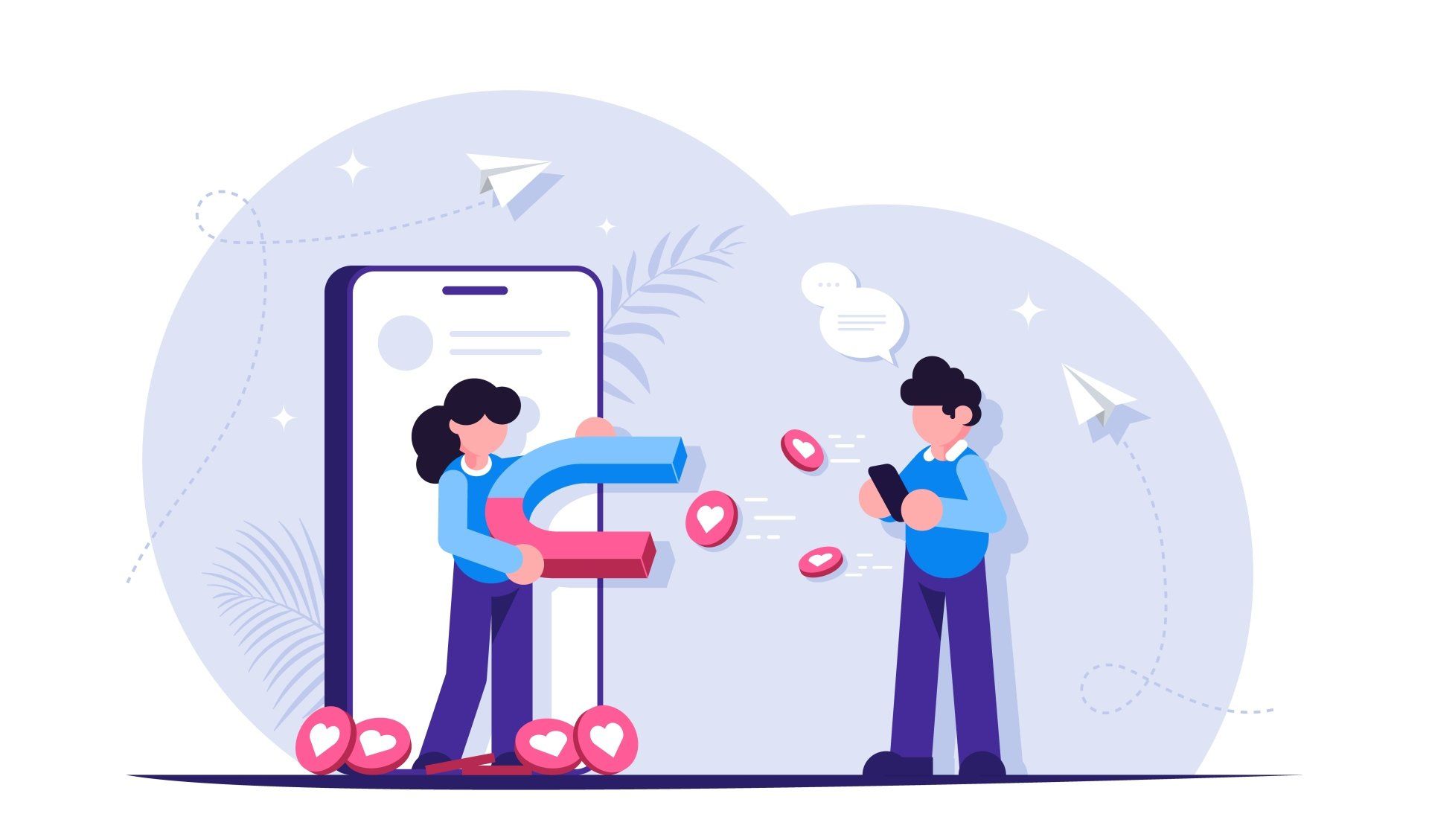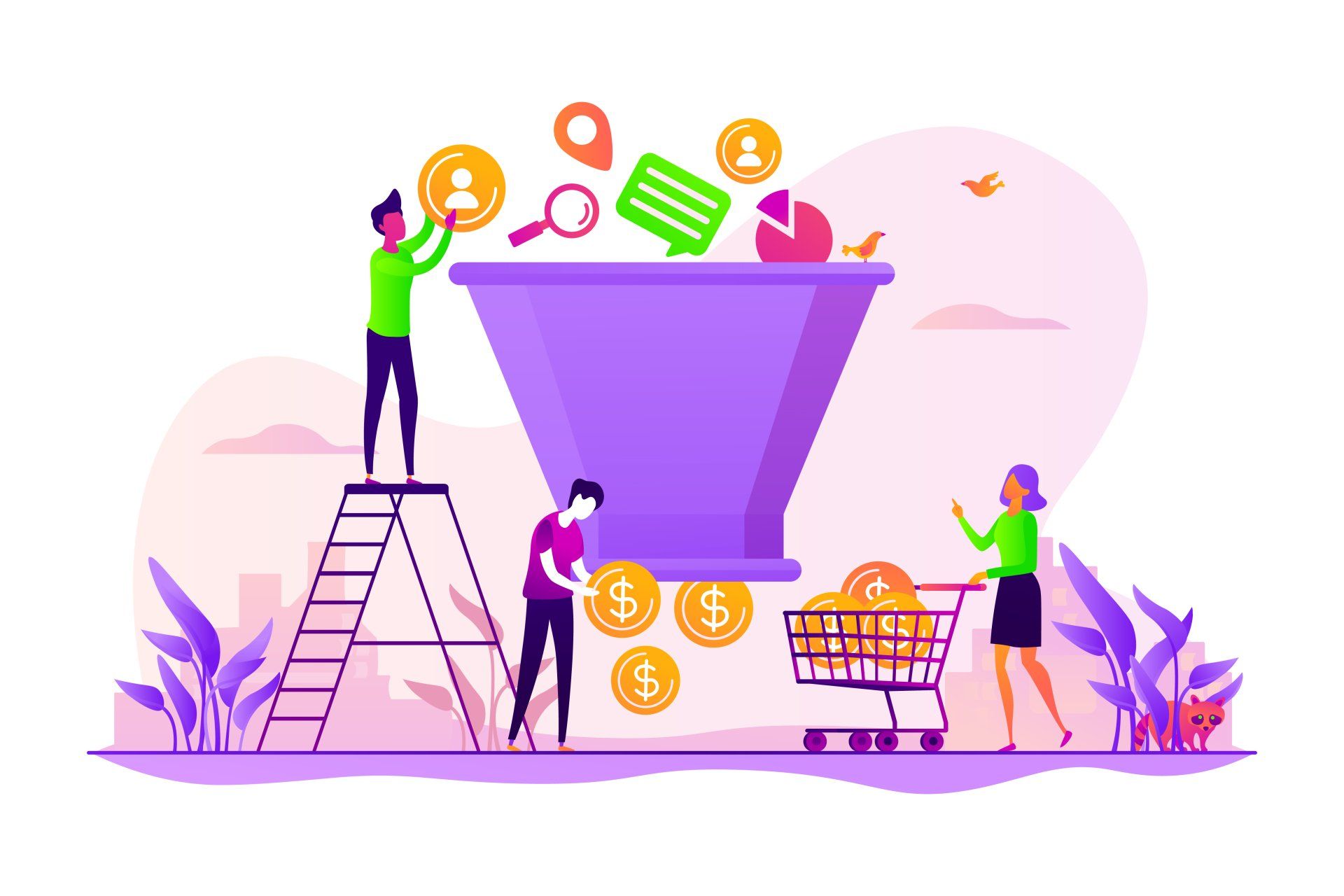10 Tried and Tested Lead Magnet Ideas
Cotswold Web • 12 May 2020
A lead magnet is something extra you can offer through your website, in return for a visitor’s contact information.
They include things like ebooks, videos and webinars, and are a really effective way of getting those valuable email addresses. But lead magnets can take a lot of time and energy to produce.

However, to save time, every blogpost in your archive has the potential to be updated and repurposed as a lead magnet to bring more leads to your website.
Before we give you some easy lead magnet ideas, we wanted to quickly run through the conversion path that will turn website visitors into leads, and the importance of email marketing in that process:
Call to action (CTA)
This is the essential button you need for blog readers and website visitors to click, so that they can access your lead magnet.
Landing page
This is where a visitor ends up after clicking on your CTA. Here they will fill in their name, email address and any other relevant contact information.
Thank you page
The visitor will then go to a page thanking them for their information.
Email the resource
As long as the visitor has given you a genuine email address, you will now be able to send them the lead magnet. This email should also be where you start a conversation with the lead, to keep them engaged with your business in the future.
Here we share 10 tried and tested lead magnet ideas that you can easily create by repurposing your existing content.
1. The mini ebook
The best lead magnets offer an attractive and instant reward to visitors, and the mini ebook definitely ticks that box.
A mini ebook is the perfect lead magnet for when you have a series of blogposts on a related subject. For example, if you sell garden furniture, you could pick the following posts from your blog to pull together into an ebook:
- Get your garden ready for summer
- Easy garden design tips for small gardens
- Outdoor lighting ideas for your garden
- How to make the best of your patio
- Outdoor entertaining in your garden
These posts could be pulled together into a mini ebook called Making the most of your garden all year round.
An ebook like this is useful to your visitors because you are making their lives easier.
Rather than searching through your website to find one relevant garden article at a time, you are pulling it together into a convenient package, which is easy for them to keep and refer back to.
2. The checklist
If you’ve got instructional posts on your blog, they should be easy to turn into checklists, which can be very useful tools for your visitors. Something like the process for planning an event would work well as a checklist.
Go back to your blogpost and simplify it into a series of bullet points, making sure you remove any points which aren’t actionable. Break it down further into several numbered steps – in the event planning example you can break it down by date from ‘two months before’ to ‘on the day’. Each of these steps should have a list of smaller actions below them, to make the end result more achievable.
To make your checklist even more useful, offer it in printable form, so that people can go through and physically tick off the actions when they’ve achieved them. Ticking an action off a checklist always feels like a great achievement, which people will come to associate with your business.
3. Resource guide
If there is already a lot of useful content available across your industry, it may be difficult to come up with an original take on it. In this case, a resource guide (or ultimate guide) is a useful lead magnet. A resource guide differs from an ebook in that it is a round-up of others’ content, rather than a round-up of your own content.
If other people have already covered a subject in great detail, you can add value by bringing the very best content together into a resource guide. A resource guide, or ultimate guide, is a collection of the best articles on a subject from across the web. It could also include the best apps, videos, or even the best books, on a topic.
When pulling together a resource guide, it is important not to copy content directly into your own article. Instead, you should link back to the original articles, with your own intros for each of them, so that your readers know why the content will be useful for them to read.
4. The workbook
A workbook is a really effective lead magnet, especially for businesses in the service sector. The very best workbooks can be used again and again.
In its most basic form, a workbook is a resource to complete with simple steps to achieve a particular end. Just seeing the steps written out in this format will help people to focus their minds on completing the task.
Internet marketing guru, Neil Patel, has a simple but effective workbook on his site for writing quality blogposts which will rank on Google.
Participants should follow a series of easy exercises as they go through the workbook, with the answers combining to form a finished piece of work. The final piece should add some value for their business – such as a finished blogpost in Neil Patel’s example.
Keep design to a minimum, and leave plenty of space in your workbook. People should be able to print it off and physically fill in the gaps on paper, as they focus their thoughts and learn by doing.
Include a call-to-action with your workbook, letting people know that you can help them apply their new knowledge, using your products or services.
5. Video
Video is one of the most effective ways of learning, and many people would rather watch a video than read copy
– particularly for a ‘How to’ video for things like DIY, craft, car maintenance or baking.
So don’t offer all your videos too freely! Offer bonus content – either something completely new or a longer version of one of your existing videos – as a lead magnet, in return for an email address.
6. Bonus Pack
The bonus pack is a very similar principle to holding back some of your video. In this case, you are offering some extra, bonus material to a blogpost, as a way to reward readers who sign up for a lead magnet. In your article Easy garden design tips for small gardens you could offer an additional five exclusive tips or links that weren’t in the original post.
In addition, offering the tips as an exclusive downloadable PDF could make it more attractive to readers when they are shopping for their garden design essentials, or starting work out in the garden.
If your bonus pack offers money-making ideas, the number of people willing to give you their email addresses is likely to increase even further.
7. Case Studies
Case studies focus on an individual real person (or organisation), who has had their life changed or improved by using your product or service. What they have to say can prompt a potential customer to follow in their footsteps and take action.
If you already have a blogpost or video or audio clip which includes an interview with a customer, you can expand on this to create a full case study. Your case study should include relevant and relatable detail about the person, which should in turn make them relatable to your audience.
The case study should continue with detail of the issue they needed to resolve and how your product or service helped resolve it for them. Finally, you should share details of their success – whether that is increasing sales by 50%, having a lawn free of weeds or having the confidence to go out again following a difficult time in their lives.
You will need to get approval from the subject of your case study for the information you are sharing, the way it is worded and any photos you use. Once you have this, it makes the perfect lead magnet to show your readers how your products or services can really make a difference.
8. The secret
Few of us can resist finding out something other people don’t know about, which is what makes the secret such an intriguing lead magnet.
The secret should be something a lot of people will find useful or interesting – and you need to sell it in a way that they can’t resist filling in their email contact details.
So if you’ve persuaded a big brand to make a change in their behaviour or even to stock your product, that sounds like just the sort of secret many people would be interested in. Write a blogpost setting the scene about your aims and the work you put in, but keep the final action as a secret eg:
Want to know how I persuaded Tesco to cut down on plastic packaging? Click here to find out.
The secret that you email out to people doesn’t need to include fancy design. They are just interested in getting straight to the point and the secret is all that matters.
Do you have anything you could offer as a lead magnet secret?
9. The Cheat Sheet
If you’ve written a blogpost about something which is useful and a lot of people could learn from, but it is also quite complicated, you could offer a cheat sheet as a lead magnet.
A cheat sheet is a one page summary of your most important points, which is easy to check back on when someone is going through a new process and needs to refresh their memory.
Whatever your industry, there is almost certainly a cheat sheet you could offer – from shutter speed in photography to stretches for marathon runners or shortcuts in Wordpress – you can create your own useful download-and-keep resource to make life easier for your readers.
10. The Webinar
A webinar is a live online talk. If you’ve written an informative blogpost, perhaps about something like new legislation, a webinar is the perfect opportunity to go into more depth. You can offer the webinar as a lead magnet in return for an email address.
Your webinar doesn’t have to involve multiple presenters. A webinar is essentially a chat between yourself and a colleague about the key points, using a live video conferencing platform. Use PowerPoint or similar to create helpful visuals to reinforce the points you are making and ensure everyone watching is getting more information than they would get from a blogpost alone.
Make sure you let people know the date and time of the webinar when they sign up, and consider running it again if the initial session doesn’t attract a very big audience.
People listening in should be able to submit questions, so you can be sure you are covering the points your audience is really interested in. Go back and follow up with these audience members after the webinar, as they are likely to be the most interested in your business, products or services.
With just a little effort, you should be able to convert your existing content into these useful lead magnets, which offer additional value to your audience and, most importantly, give you the contact details you need to keep building your business.
More Posts.

In today's digital landscape, effective content marketing can be the key differentiator for small businesses striving to stand out. As consumers increasingly turn to online platforms for information, brands must engage their audiences through valuable content that resonates with their needs. Understanding the nuances of content marketing is crucial; it encompasses various strategies designed to attract, inform, and delight customers while ultimately driving sales. From developing engaging customer personas to measuring success through specific metrics, small businesses have an incredible opportunity to refine their marketing approach. This article explores eight proven strategies that can lead to content marketing success for small businesses, equipping you with the tools necessary to create impactful and sustainable marketing efforts. 1. Understanding the Importance of Content Marketing Content marketing is vital for small businesses. It helps connect them with their target audience, builds brand awareness, and drives organic traffic. A well thought out content marketing strategy lets small businesses compete with larger companies by using cost effective methods. Regularly sharing valuable content can position a business as an expert in its field. This fosters trust and encourages potential customers to seek their services. Documenting your content strategy also increases the chances of seeing your marketing efforts as effective, allowing a higher allocation of budget toward content marketing. Creating a diverse range of content types is key. Here are some content formats to consider: Blog Posts Social Media Posts Email Marketing Visual Content Developing a strategic content plan helps business owners carve out unique market spaces. Establishing clear business goals and using tools like Google Analytics to gauge conversion rates can refine your approach. Below is a quick checklist for effective content marketing: Know your target audience Set SMART goals Use a content calendar Perform a content audit By focusing on these elements, small businesses can enhance their content marketing efforts and achieve growth. 2. Developing Customer Personas for Targeted Engagement To create targeted content, small business owners should develop detailed buyer personas. These personas are fictional versions of ideal customers, including demographic and psychographic details. Tools like Google Analytics and social media insights provide valuable data to shape these personas, making them more accurate. Understanding your target audience through buyer personas is key. It allows content marketers to tailor pieces of content that address specific needs and challenges. This approach boosts engagement and builds trust with potential customers. It is often necessary to have multiple personas to cater to various products, services, or customer segments. Each persona reflects different motivations and interactions with your brand at various stages of the customer journey. Here's how you can develop them: Collect Data: Use surveys, Google Analytics, and social media insights. Analyse: Determine the needs, interests, and behaviours of your audience. Create Multiple Personas: Define different segments based on your findings. Tailor Content: Use the personas to guide your content marketing efforts. Effective personas lead to a successful content marketing strategy, enhancing your business goals with every piece of content created. 3. Crafting a Comprehensive Content Plan Creating a successful content plan is key for small business owners. It acts as a guide to align all your content marketing efforts with your business goals. Here’s how you can craft a comprehensive content plan: Identify Key Topic Areas: Focus on subjects relevant to your target audience. This ensures you create valuable content that speaks directly to potential customers. Choose Content Types: Use a mix of blog posts, infographics, and videos. Different content formats can help engage various segments of your market. Plan Distribution Channels: Decide where to share your content. Consider social media posts, email marketing, and your website for maximum reach. Set Calls to Action: Encourage your audience to take the next step. This could be signing up for a newsletter or visiting a product page. Utilise a Content Calendar: This keeps your content marketing strategy organised and consistent, minimising missed opportunities. Analyse Metrics: Use Google Analytics to track conversion rates, engagement, and content performance. Including these elements in your content plan aligns with the fact that structured strategies significantly boost success rates. Regular content audits refine this strategy further, ensuring continued engagement and growth .

Heading 1 Artificial intelligence (AI) has had a huge impact in many areas of life and SEO is no exception. While it has made online searches easier for consumers, keeping up with it and staying ahead as a business can be challenging. As Google integrates advanced AI into its search results, businesses must rethink their SEO strategies. Understanding the future of SEO in the context of AI is essential to appear high on search rankings and remain competitive. Traditionally, search engine optimisation (SEO) has relied largely on keyword optimisation and link building. If you sell garden products, you would make sure the phrase ‘garden products’ was used frequently throughout your website. You would also look to get some links back to your site from other websites – maybe other businesses in your local area or in a complementary sector. These traditional SEO methods are becoming less effective. AI means search engines like Google and Bing have become better at understanding the intent behind a search, through machine learning algorithms analysing huge quantities of data, as well as natural language processing. Natural language processing doesn’t just understand the words in a query, it understands the context and intent behind it. AI can even understand synonyms, slang and regional variation in language! When someone searches for something online, AI can analyse, interpret and predict their behaviour. So businesses have to adapt their SEO strategies to changing algorithms to stay competitive. You need to have a deeper understanding of your target audience and produce content which meets their needs and answers their queries. It is about providing the best answer to the questions your audience is asking, because AI algorithms are skilled at recognising content which meets the search intent of users and provides value. This means that content which is designed to meet specific needs, answer questions and provide the solutions to problems is more likely to rank higher in searches. AI algorithms will prioritise content which resonates with users on a human level – with every paragraph adding more value and depth. This aligns with AI’s preference for content which engages and informs – and also helps build a stronger connection with your target audience. In addition, AI is making voice searches (e.g. Alexa) much more effective. Voice searches tend to use more words than online searches e.g. ‘find me healthy snacks for pre-school children’ rather than just typing ‘healthy snacks’ into Google with no context. This aspect of AI will continue to grow in importance and become even more widely used.








